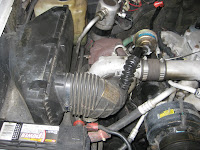I figured the best place to start sorting things out was getting the hood to close and getting all the engine driven accessories (A/C compressor, power steering, alternator, etc.) installed. The original GMC mounting of the alternator resented a problem. The alternator was about an inch too high to allow the hood to close. After considering a couple of options for relocating it I realized I could just rotate the alternator down on its main mount by modifying the alternator support bracket.
 |
| Original alternator mount |
 |
| Lower mount |
Moving the alternator meant screwing up the geometry of the serpentine belt tensioner. I made a relocation bracket to rotate the tensioner over and down to get it in the same position relative to the alternator as it was before.
Success! The tensioner works correctly and the original length belt still fits...
But just barely! Down at the power steering pump there's only about 1/8" clearance between the belt and the upper control arm pivot shaft. Not much, but it's enough!
The finished bracket with power steering pump reservoir.



































































